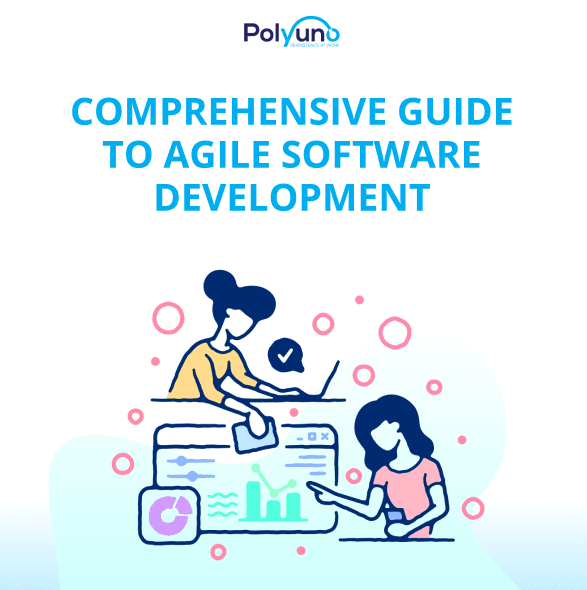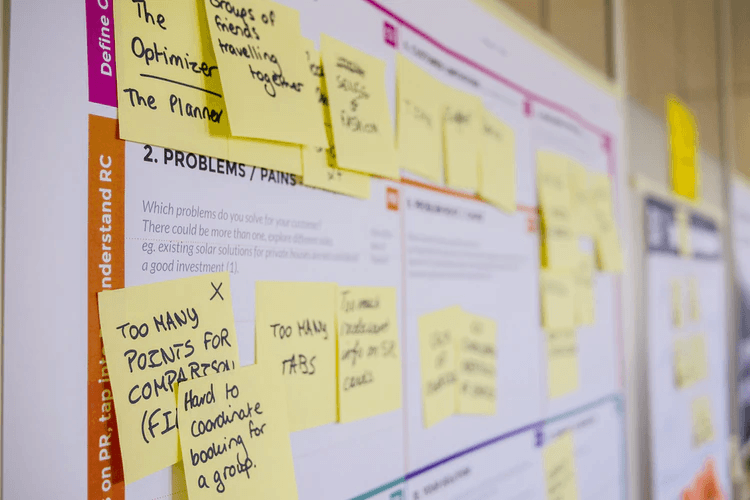

Agile is one of the most popular and widely used software development frameworks in the world. Many Software Agencies vouch for its positive impact on efficiency and growth.
The agile approach allows businesses to adapt to emerging trends in the fast-paced software industry. It also allows team members to break down lengthy processes into small segments to create and test software.
According to the 15th Annual State of Agile survey, 95% out of 4,000 respondents prefer the Agile Software Development methodology. This promotes cross-functional teams across the organization, which eventually speeds up the entire development process.
But agile can be quite an elusive concept to grasp for beginners.
In this article, we’re covering all you need to know about agile software development, providing you the answers to all your questions regarding the agile framework.
Agile is the ability to generate and adapt to changes. It is a technique of dealing with and ultimately excelling in an unpredictable and turbulent environment.
The creators of the Agile Manifesto picked the term Agile as the word reflects the adaptability and responsiveness to change that was so crucial to their approach.
It’s basically about figuring out how to comprehend what’s going on in the environment you’re in right now, identifying the uncertainty you’re facing, and thinking through how you can adjust to it as you go along.
There were software developers who initiated working in an Agile fashion before 2001. They started mixing old and new ideas and found a combination that works.
Then they created a methodology for their team and beyond. They emphasized close collaboration to figure out smart ways to craft, confirm and deliver codes. This is the time when frameworks such as Scrum, Feature-Driven Development (FDD), Extreme Programming, Dynamic Systems Development Method (DSDM) started to appear.
The software developers were all doing different approaches to developing software. Then they thought they should sit together and agree on a specific manifesto.
This gave birth to the manifesto for Agile Software Development.
The manifesto formed the foundation by providing a set of value statements. After that, the authors expanded the ideas into 12 Principles of Agile Manifesto.
After the formation of the Agile Alliance in 2001, managers, teams, organizations started to adopt Agile. People who live up to Agile values and principles started realizing the benefits they sought.
They find that working in an Agile fashion is no longer new and different. It is simply the way they approach work.
Agile software development is an umbrella term for a set of frameworks and practices based on the values and principles demonstrated in the Manifesto For Agile Software Development and the 12 Principles.
This is one of the simplest and effective processes to turn a vision for a business need into software solutions.
Adopting Agile Software Development in teams and organizations means following the practice that helps with collaborating and self-organizing the work. That doesn’t necessarily mean there are no managers.
Rather, it means they maintain cross-functional teams containing people with the right skill sets. It also includes continual planning, learning, evolutionary development and improvement, and early delivery. It encourages flexible responses to change and uncertainty.
When approaching software development in a certain way, it is typically beneficial to live by these values and principles and utilize them to choose the appropriate things to accomplish given your specific context.
Agile Software Development emphasizes four core values.
People drive development processes and respond to customer demands. They are, without a question, the most essential aspect of growth. They should be valued more than processes and tools.
If employees place a higher value on procedures and tools, they will be less likely to adapt to change and, as a result, will be unable to satisfy the demands of their customers.
The Agile Manifesto does not forbid the usage of documentation, rather it emphasizes the importance of working software. The process of documenting the product throughout its development for delivery is tedious and cumbersome. It is lengthy, resulting in needless delays.
The Agile Manifesto simplifies this process by providing the developer with only the information required to continue with the project.
Customers are involved in the Agile Software Development process at all stages. They will be able to contact the teams regularly, attend meetings, and ensure that the products fulfill their expectations. In this way, Agile emphasizes collaboration rather than a negotiation between consumers and management.
Though traditional software development considered changes to be undesired costs, Agile thinks that changes are always a means to enhance the project and add marginal value to it. It enables modifications to be made quickly and assists the team in tailoring the process to their specific needs.
The 12 Principles behind the Agile Manifesto are:
The Agile software development cycle consists of six stages: concept, inception, iteration/construction, release, production, and retirement.
This view depicts the whole Agile lifecycle model in the company. In every company, many projects may be running at the same time, various sprints/iterations may be documented on separate product lines, and a variety of clients, both external and internal, with a diversity of business demands.
The Agile Methodology is an advanced technique for developing software that is both flexible and fast. Simply, these methods are the norms that a team chooses to adhere to Agile values and principles.
To assure failsafe and faster delivery, the approach incorporated new notions of iterative and incremental development techniques.
The Agile software development technique allows for backward tracking and helps the development team to construct a larger feature set in time-boxed cycles.
It follows a standard development process, beginning with requirement collecting and ending with design, development, testing, deployment, and maintenance.
The Agile technique, on the other hand, alters the strategy at each stage.
Kanban is a Japanese term that means "visual board or signboard" and is related to the notion of "just in time"! It was initially conceived as a lean manufacturing method, the Kanban idea has spread to agile software development teams.
This technique employs visual methods for project development and management.
Kanban projects are managed with the aid of the Kanban Board, which is separated into columns to show the software development process flow.
This improves team visibility since teams can observe progress at each stage of development and plan for forthcoming activities to deliver the product "just in time"!
This technique necessitates extensive contact and openness for team members to be armed with the appropriate stage of development at any moment and to maintain a continuous flow of work.
The agile scrum development process, which is represented by multiple development cycles, is one of the most prominent agile methodology examples.
Scrum, like Kanban, divides development periods into stages or cycles known as ‘sprints.' The development time for each sprint is optimized and focused, allowing just one sprint to be managed at a time.
Because Scrum and agile approaches emphasize ongoing deliverables, this strategy allows designers to modify priorities to guarantee that any unfinished or late sprints receive further attention.
The Scrum Team has dedicated project responsibilities, such as a scrum master and a product owner. Besides, it also ensures continual communication on the daily scrum, where activities are coordinated to design the best method to accomplish the sprint.
Extreme Programming (XP) is a software development technique that emphasizes collaboration, communication, and feedback. It prioritizes continuous improvement and client satisfaction.
XP, like scrum, employs sprints or short development cycles. A team creates this to create a productive and highly efficient workplace.
In a circumstance where consumers' expectations are continuous and fluctuating, the Extreme Programming method comes in handy. It encourages developers to embrace changes in client needs, even if they occur late in the development process.
In Extreme Programming, the project is tested from the beginning by gathering input that advances the system's output. This also serves as a quick check to ensure that any client needs are readily implemented.
Crystal is one of the main figures in developing the Agile manifesto for software development. It is a collection of smaller agile development techniques, which includes Crystal Yellow, Crystal Clear, Crystal Red, Crystal Orange, and others.
Each has its own distinct and distinct structure, which is defined by criteria such as system criticality, team size, and project priorities.
The kind of crystal agile methodology is chosen according to the nature of the project or system criticalities, such as Comfort (C), Essential Money (E), Discretionary Money (D), and Life (L).
Like other Agile methods, Crystal focuses on software delivery, regularity, minimal administration with high user participation, and customer satisfaction.
The Crystal family believes that each system or project is unique and requires the incorporation of many practices, procedures, and policies to get the best outcomes, earning the title of the most lightweight agile methodologies.
The Dynamic Systems Development Method (DSDM) was created to meet the demand for a common industry charter for the rapid delivery of software.
DSDM provides a complete structure that can be created and updated to build a plan, execute, manage, and expand the software development process.
Based on a business-driven strategy and eight principles, the DSDM believes that project adjustments should always be expected, and quality with timely delivery should never be bargained.
The Agile Software Development Methodology is an ideal technique for focusing on speed and flexibility. An increasing number of development firms are adopting this technique because of its multifarious benefits.
The trick to creating market-ready software is to adhere to the Agile Methodology while also embracing the Agile mindset. The method is the correct approach for implementing change in the marketplace.
It is about responding to your consumers' input as fast as possible without delaying the completion of your project. It's about planning and distributing your product in small, regular increments to allow for ongoing development at a lower cost.
If you’re looking for a customer-focused agency for building a software solution that is adaptable and scalable, PolyUno is the perfect fit for you.
Request a quote now!